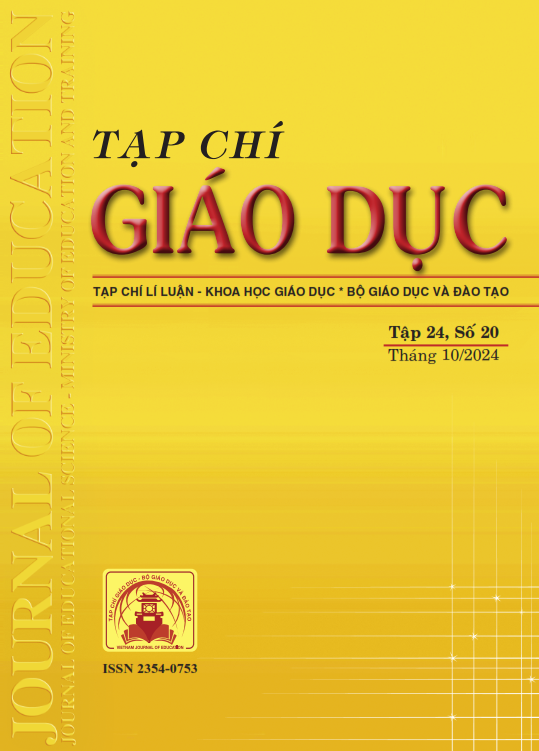Vận dụng mô hình 5E trong dạy học chủ đề “Đạo hàm cấp hai” (Toán 11) theo hướng phát triển năng lực giải quyết vấn đề toán học cho học sinh
Tóm tắt
The 5E model is a teaching model that plays an important role in encouraging students to come up with solutions and ideas for specific problems, thereby helping students memorize and interpret the problem better. The topic “Second-order derivatives” in the 11th grade Math program is a core content, with many applications in mathematics and other related subjects. This is a difficult topic to approach in both teaching and learning. The article presents some key points about the 5E model, the relationship of this model with students' mathematical problem-solving competency and illustrates the application of the 5E model in teaching the topic “Second-order derivatives” (Math 11) to develop students' mathematical problem-solving competency. Correctly applying the 5E model in the direction of developing mathematical problem-solving competency will bring students excitement in learning, create opportunities to “rediscover” knowledge and perceive how to apply it to solve practical problems.
Tài liệu tham khảo
Atkins, J. M., & Karplus, R. (1962). Discovery or invention? The Science Teacher, 29(5), 45-51.
Bộ GD-ĐT (2018). Chương trình giáo dục phổ thông môn Toán (ban hành kèm theo Thông tư số 32/2018/TT-BGDĐT ngày 26/12/2018 của Bộ trưởng Bộ GD-ĐT).
Bybee, R. W., Taylor, J. A., Gardner, A., Scotter, P. V., Powell, J. C, Westbrook, A., & Landes, N. (2006). The BSCS 5E Instructional Model: Origins, Effectiveness, and Applications. The BSCS 5E Instructional Model: Origins and Effectiveness. Office of Science Education National Institutes of Health. BSCS 5415 Mark Dabling Boulevard Colorado Springs, CO 80918.
Bybee, R. W. (2014). The BSCS 5E instructional model: Personal reflections and contemporary implications. Science and Children, 51(8), 10-13.
Herbart, J. (1901). Outlines of educational doctrine (C. DeGarmo, Ed. & A. Lange, Trans.). Macmillan. (Original work published 1835).
Lê Văn Tiến (2019). Phương pháp dạy học môn Toán. NXB Đại học Sư phạm TP. Hồ Chí Minh.
Lesh, R., & Zawojewski, J. S. (2007). Problem Solving and Modeling. In Lester, F., Ed., Second Handbook of Research on Mathematics Teaching and Learning, Information Age Publishing, Greenwich, CT, 763-802.
Nguyễn Ngọc Hà, Nguyễn Văn Thái Bình (2020). Phát triển năng lực giải quyết vấn đề toán học trong dạy học giải phương trình bằng phương pháp vectơ ở trường trung học phổ thông. Tạp chí Giáo dục, số đặc biệt kì 1 tháng 5, 98-104.
Nguyễn Thành Hải (2019). Giáo dục STEM/STEAM: Từ trải nghiệm thực hành đến tư duy sáng tạo. NXB Trẻ.
Phạm Thị Hồng Hạnh, Chu ThịMai Quyên (2020). Sử dụng mô hình 5E thiết kế kế hoạch dạy học Chương 2, Hình học lớp 11 theo định hướng giáo dục STEM. Tạp chí Khoa học Giáo dục Việt Nam, 30, 19-24.
Runisah, Jarnawi, A. D., & Tatang, H. (2016). The enhancement of student critical thinking skill in mathematics through the 5E learning cycle with metacognitive technique. International Conference of Mathematics and Science Education, 101-106.
Tezer, M., & Cumhur, M. (2017). Mathematics through the 5E instructional model and mathematical modelling: the geometrical objects. EURASIA Journal of Mathematics Science and Technology education, 13(8), 4789-4804.
Walia, P. (2012). Effect of 5E instructional model on mathematical creativity of students. Golden Research Thought, 1(10), 1-4.
Tải xuống
Đã Xuất bản
Cách trích dẫn
Số
Chuyên mục
Giấy phép

Tác phẩm này được cấp phép theo Ghi nhận tác giả của Creative Commons Giấy phép quốc tế 4.0 .












